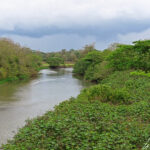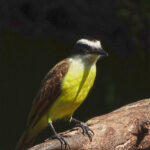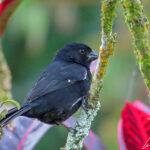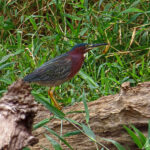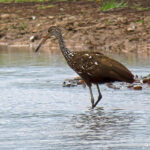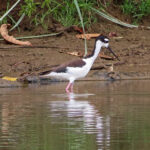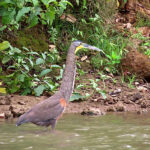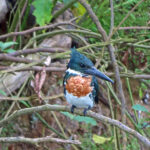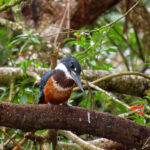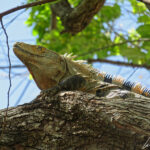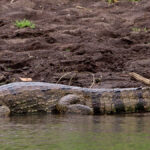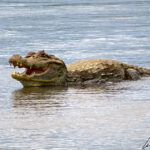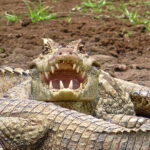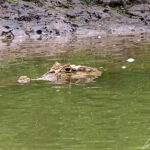The Refugio Nacional de Vida Silvestre Caño Negro, the largest wetland in Costa Rica, is located on the northern plains of the province of Alajuela near the border with Nicaragua. The reserve is remote and off the beaten path and tourist circuit. The closest village is Los Chiles to the northeast on the Rio Frío and 1h30 from the Arenal volcano. The reserve of Caño Negro can be visited by canoe, kayak, or small flat-bottomed boat. On the waters of the Rio Frío peace and serenity are only disturbed by the boat moving through the water and by birds. However, be careful not to let your hands linger in the water… Distinguished guests, belonging to the order of crocodilians, lounge on the banks may fancy fresh flesh…
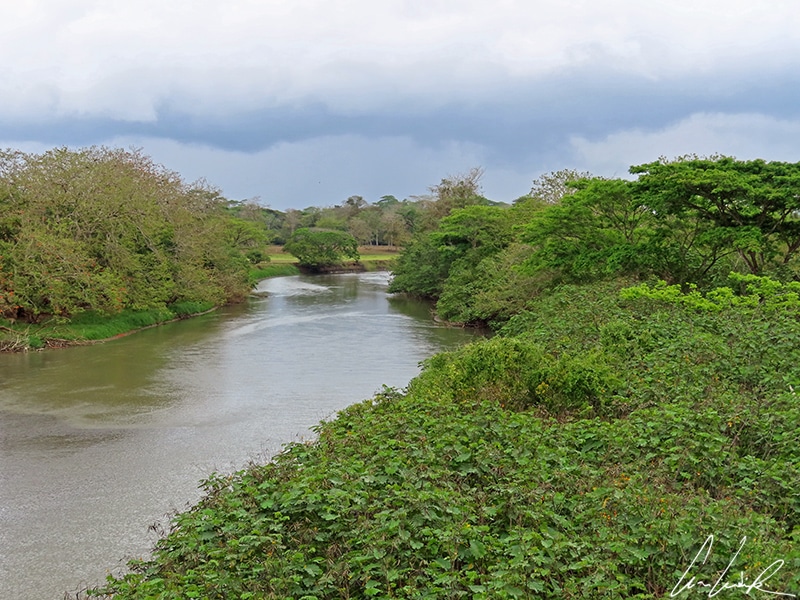
The Caño Negro Wildlife Refuge
Caño Negro National Wildlife Refuge, Costa Rica’s Paradise of Birds
The Wildlife Refuge was created in 1984 to protect the Rio Frío and its flood plains from development. The Silvestre Caño Negro National Wildlife Refuge is 24.6 acres of wetland. The elevation ranges from 98 to 328 feet above sea level. In December 1991 this reserve was the first RAMSAR (Wetlands of International Importance) site to be designated in Costa Rica. It is on a key migration route for birds coming from the north and a vital stopover for them. It also provides habitats for thousands of resident species. The best time to visit this national refuge is when migratory birds pass, from January to March. Bird watching is generally easier in open or semi-open areas than in wooded areas. We find birds of all kinds. Moreover, a boat ride allows a more efficient approach: a small boat is less scary for the birds than a group of hikers! Experienced ornithologists or novice ornithologists eager to learn and discover the abundant birdlife of this reserve are welcome aboard our boat. A beautiful day ahead for navigation on the canals of the Rio Frío !

A Panamanian Flycatcher
The Caño Negro Refuge is a magical place. There is a feeling of peace and tranquility mixed with the enthusiasm of the amateur ornithologist. As soon as we arrive at the pier, we are welcomed by two tyrants! Not tyrants (τύραννος) in the Greek sense of the word, but rather birds, of the passerine genus, which are known to be very aggressive. Despite their small size of about 9 inches, tyrants freely attack larger birds to protect their territory. Thus, the tyrant is not afraid to dive down on the back of a bigger bird and hammer its head with his beak. In short, as I said, we are welcomed with a fanfare of passerines: a Panamanian Flycatcher (Myiarchus panamensis), a Great kiskadee (Pitangus sulphuratus), and a Blue-black grassquit (Volatinia jacarina). The Great kiskadee is very vocal. Its most common call is a “kiss-ka-dee” (What did you say?) with a more or less long series of “dee”… The family Tyrannidae occurs in North and South America. They are a family of birds known to exist throughout the world and number more than 400 species. In general, the Tyrannids are gray on top and yellow on the bottom. As for the Blue-black grassquit, the only member of the genus Volatinia, the male is a spectacular jumper, which gives rise to the local English name « Johnny Jump Up » What, you have never heard the Irish song “Johnny Jump Up?” It is about a man who gets into trouble after drinking too much extra-strong cider ?

A Great Kiskadee
The waders of Caño Negro: aquatic birds with long legs and neck
The Caño Negro wetland refuge is home to several hundred species of birds. We drift slowly on the peaceful waters of the Rio Frío in front of micro-cliffs of earth at the foot of which some wading birds are fishing, standing motionless, or on the lookout. These birds have long legs and a long neck, a morphology ideally suited to their way of life. These two attributes allow them to seize food in the water without wetting their feathers !
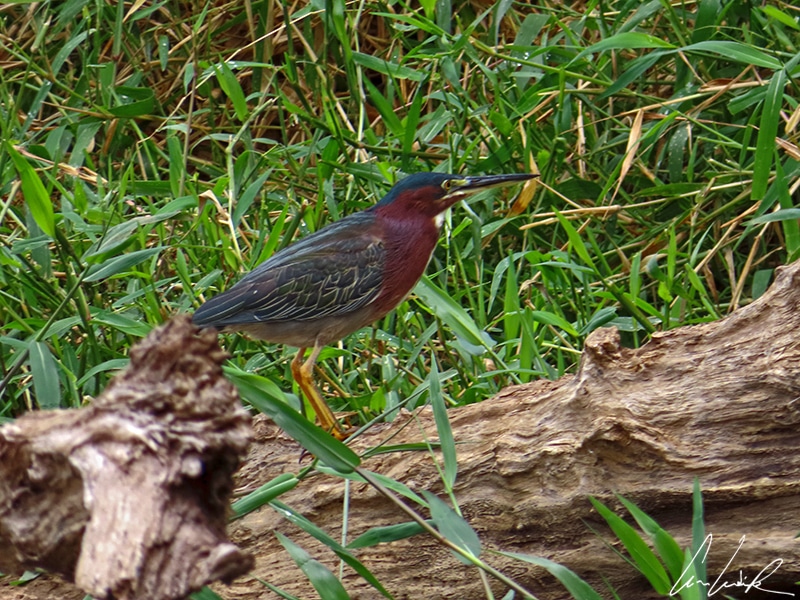
A Green Heron
We see a Great egret (Ardea alba), also known as the Common egret or great white egret, on the right bank. It is recognizable by its very long S-shaped neck, with a break in the middle. The Great egret is a large heron with all-white plumage. Soon we come upon a Cattle egret (Bubulcus ibis) displaying its nuptial plumage: orange-buff plumes on the back, breast, and crown. The bill, legs, and irises become bright red for a short period before mating. A discreet bird, the Green heron (Butorides virescens), is a small heron. Adults have a greenish-black cap, a green back, chestnut neck, a white line down the front, grey underparts, and short yellow legs. This small heron is challenging to spot because of its behavior. It flies away at the slightest danger in a dour mood while shouting its « kuk-kuk » calls. We drift now past sandy beaches where other species of waders live, such as the Limpkin (Aramus guarauna), also known as the crying bird. It is a large wading bird and related to cranes. Its plumage is dark brown with an olive luster above. Further away is the graceful Black-necked Stilt (Himantopus mexicanus) with long pinkish legs and a long thin black bill. It is white below and has black wings and back. The Costa Ricans call the Black-necked stilt « soldadito » (little soldier) because of its martial gait.

A Black-necked Stilt
The Bare-throated tiger heron (Tigrisoma mexicanum) is the largest of all the species! Its plumage is a subtle mix of black, white, buff, chestnut, and gray. It has a dagger-shaped black bill. It stands motionless, half-hidden by foliage waiting for suitable prey to come within reach of its long bill. As for the Northern Jacana (Jacana Spinosa), it is sometimes nicknamed the « little water chicken » or « little Mexican chicken » because of its vague resemblance to a chicken. Adults have dark brown plumage with a black head and neck. Its bare parts are remarkable. Its bill has yellow patches with a white base, and its forehead has a yellow wattle in the shape of a small butterfly. The Jacanas are identifiable by their huge feet and claws, which allow them to walk on floating vegetation. Did you see it ?
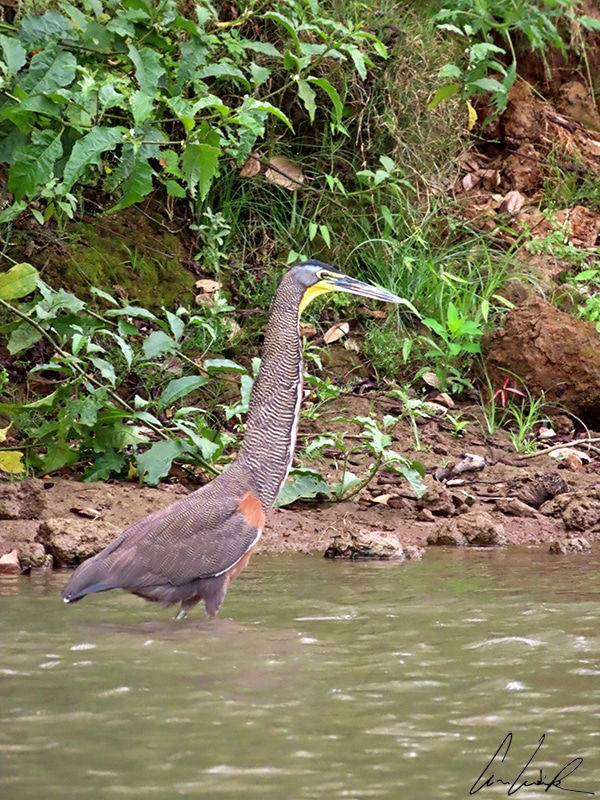
A Bare-throated Tiger-Heron
Caño Negro: watching virtuoso birds fishing
Perched on the top of an isolated branch on the riverbank, a male Amazon Kingfisher (Chloroceryle amazona) proudly displays its brightly colored plumage with hues of green, orange, and white. A Ringed Kingfisher (Megaceryle torquata) can also be seen with blue-gray slate plumage and a particularly imposing and powerful dagger-like bill that can reach 3.70 inches. All Kingfishers have a large head and long, sharp, pointed bills. The plumage of most kingfishers is bright, with green and blue being the most common colors. The brightness of the feathers is undoubtedly beautiful, but that is not their only quality! The moment the kingfisher breaks through the surface of the water, its thick, tight down becomes a waterproof suit. When it is time to fish, its stiff wings turn into two flippers against which it leans as it shoots out of the water.
« Ha! How do you do, Sir Raven ?
Well, your coat, sir, is a brave one !
So black and glossy, on my word, sir,
With voice to match, you were a bird, sir,
Well fit to be the Phoenix of these days ».
(Jean de La Fontaine – The Raven and the Fox Book I – Fable II)
The kingfisher sits on the lookout, choosing a branch, a pontoon, a boat, or any other support offering a view of the water, ideally at the height of 3 to 6 feet. It is the sworn enemy of the fish of the Rio Frío: Small Tarpon, Jaguar Cichlid (Parachromis managuensis), Freshwater drum, or Sea Bass fear its lightning dive, and then it comes out of the water in a flash. Watch out; the competition for fishing is tough…
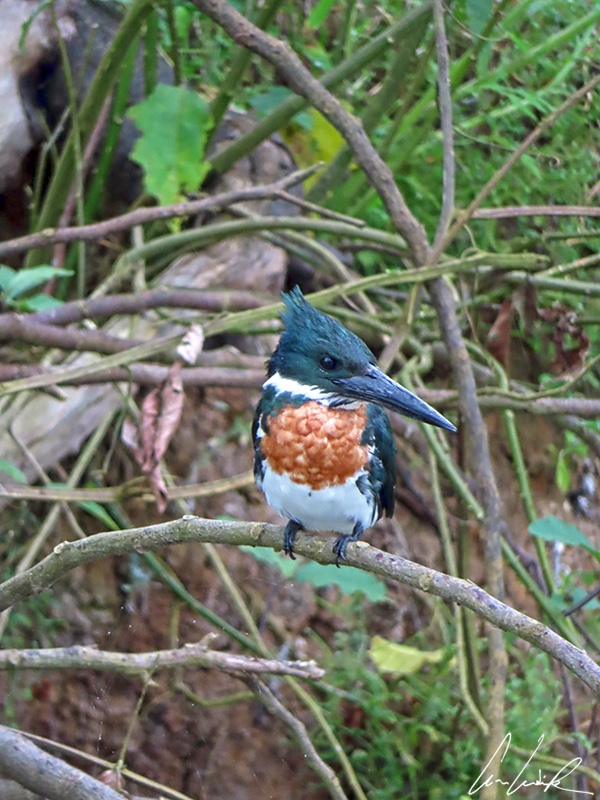
A Male Amazon Kingfisher
The impressive Black-collared hawk (Busarellus nigricollis) stands on a high open perch. This bird of prey plunges from the air, wings half-closed, and feet first into the water, usually shallow water or water covered with vegetation. It captures its prey with its claws without even needing to submerge ! Like the Osprey (Pandion haliaetus) the toes of the Black-collared hawk are covered with short rigid spicules (small spines) that allow it to efficiently grip its prey, which is known to be slippery.
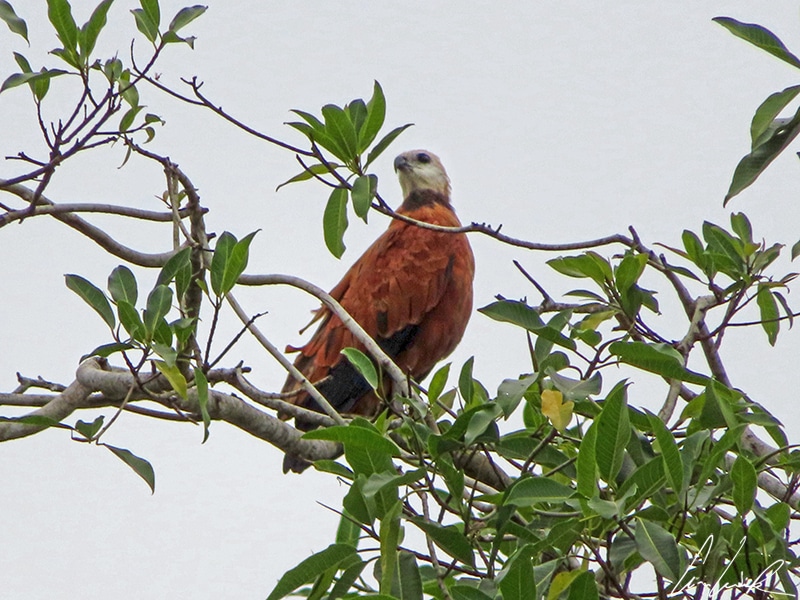
A Black-collared Hawk
We continue our slow navigation through the Caño Negro Refuge with eyes on the lookout for more feathered bills in the mangroves. Perched on a branch, an Anhinga (Anhinga anhinga), also called American darter or Water turkey, dries itself, wings wide open and tail spread facing the sun, before it can fly effectively. The reference to water turkey comes from this drying position, which resembles a male turkey. The word anhinga comes from the Brazilian Tupi language and means “devil bird” or “snake bird.” The Anhinga is an excellent swimmer on and under water. It dives with tremendous ease: its prey is usually harpooned by its long sharp-pointed bill after a generally brief pursuit! Unlike most waterfowl, which coat their feathers with oil produced from their uropygial gland, Anhingas, like Cormorants, do not have waterproof feathers. They get wet. Similar to the Anhingas, the Neotropic cormorant (Phalacrocorax brasilianus) also needs a drying session. Like Anhingas, the Neotropic cormorant stands with wings widespread perched on a rock or trunk. The Neotropic cormorant is the most widely distributed Cormorant in tropical America, and the only one found far inland from the coast. Adult plumage is very dark purplish-black with bronze highlights on the wings. Its eyes are emerald green. An outstanding swimmer and diver, it fills its plumage with water to increase its weight to facilitate diving.

An adult male Anhinga
Fauna of Caño Negro Refuge: my cousin the caiman called the bird !
While the refuge of Caño Negro is the ideal place to track down birds of all kinds, this small wild corner shelters varied fauna all along the Rio Frío: turtles (The yellow-bellied slider), iguanas, sloths, howler monkeys, basilisks running or not on the water, thousands of caimans and even an American crocodile measuring almost 12 feet. The Refugio Nacional de Vida Silvestre Caño Negro is also well-known for its diversity of mammals… it is here that some visitors have seen pumas, jaguars, and tapirs !
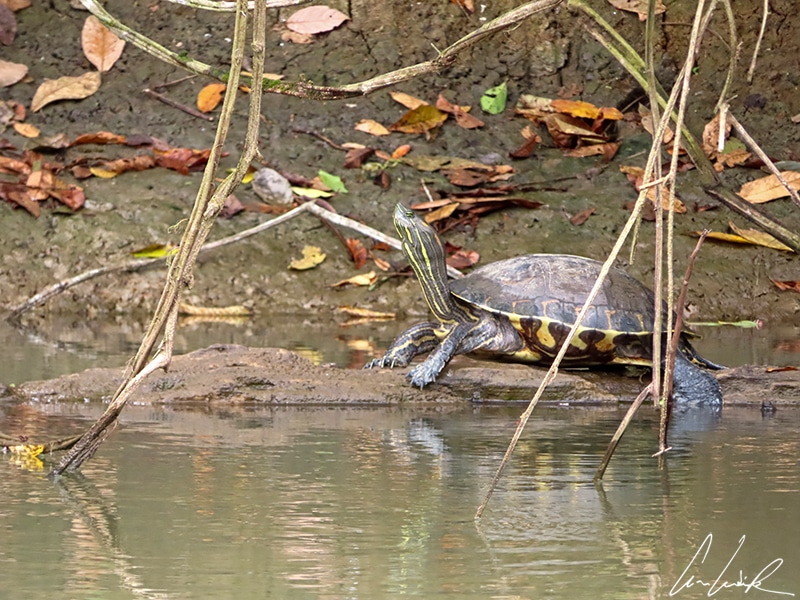
A yellow-bellied slider
Sunbathing onshore or swimming in the water, the Spectacled caiman (Caiman Crocodilus), also known as White caiman or Common caiman, is omnipresent. They welcome us with their mouths wide open… It is, in fact, a means of cooling by the evaporation of oral moisture, like transpiration in mammals. Thanks to this temperature regulation mechanism, caimans can stay several hours resting in the sun without risking overheating. Mouth opens with a full smile and teasing teeth… we will not imprudently risk our hand by imprudently letting it dangle within reach of a crocodile ! Victims of their unprepossessing looks, only one glance at this animal and its long jaw full of sharp teeth make clear its danger…
« Sweet smiles which cost so little when one’s teeth are good. »
(Alfred de Musset – The Two Mistresses)
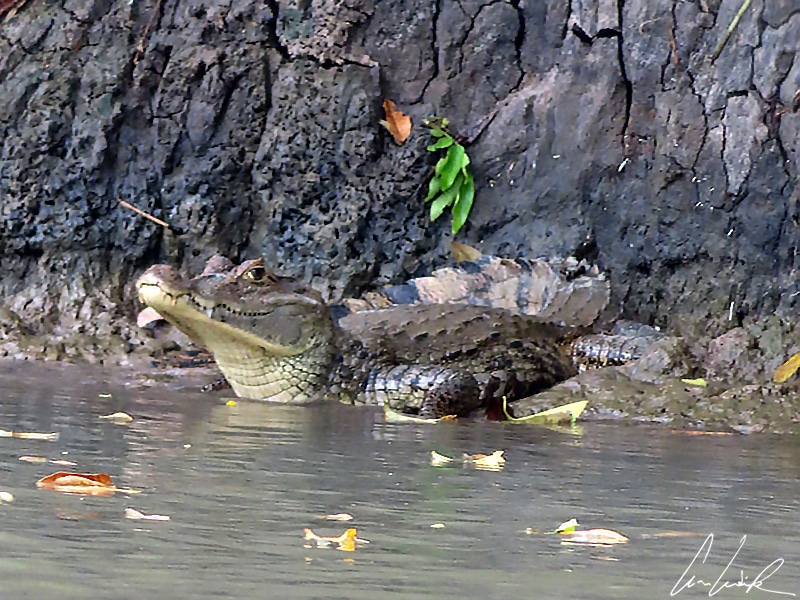
Spectacled caiman, Sunbathing onshore at Caño Negro
Contrary to their image as voracious predators, spectacled caimans consume little because their metabolism is slow. They are nocturnal and usually hunt at dusk or during the night. They are predators of aquatic invertebrates and shoreline vertebrates. Immersed in water, the Spectacled caiman watch for their prey, then pounce on it and kill it with a bite or swallow it directly. The spectacled caiman quickly locates its prey thanks to its overdeveloped senses (smell, hearing, vibration detection). Its incredible ability to hold its breath allows it to stay underwater for extended periods, as long as 50 minutes, to hunt or digest. Its lungs can move towards the front or back of its body, allowing it to keep its head underwater while its body remains submerged. This strategy of concealment is very effective in surprising its prey.

Spectacled Caiman immersed in the Rio Frio
Rarely measuring more than 8 feet, the spectacled caiman frequents the freshwaters and swampy areas, mangroves, and slow-moving rivers of the submerged rainforest. Its name comes from the spectacle-like ridge between its eyes. It has a greenish iris and wrinkled eyelids. Its color is brownish-, greenish-, or yellowish-gray.
It has a long pointed but also rounded snout (a characteristic of alligators). Like all crocodilians, the spectacled caimans have a solid bond with their young. Females stay close to their nest during the incubation process and take care of their young for about 18 months. Perhaps we should see a link with evolution: crocodilians have the same common ancestor (the archosaurus) as birds, which are also known for taking care of their offspring! If you look hard enough, you might even find other common characteristics. Did you notice that birds have scales on their legs… like our crocodilians? I know, it is a bit of a short argument! On the other hand, did you know that birds and crocodilians both have a gizzard? This specialized stomach is used for grinding up food, with particles of stone and contractions. This allows them to eat the most resistant food… They also have a common feature in their eyes: in addition to the eyelids, they are endowed with a nictitating membrane, a transparent third eyelid. This nictitating membrane allows them to see underwater while protecting the eyes from water. Also, their eggs are identical, i.e., provided with a thick calcareous and breakable shell. Another common point between birds and crocodilians: even before hatching, the newborns can communicate with each other and with their mother by emitting small sounds! In conclusion, I would say that the Caño Negro refuge shelters a big and very old family: all the birds, caimans, and turtles currently populating the refuge are descended from the same dinosaur grandfather who lived 250 million years ago…
Find more on Costa Rica
- Explore the cloud tropical forests of Costa Rica
- Costa Rica: A Vast Reservoir of Biodiversity
- Arenal Volcano National Park, a natural wonder
- Fauna and flora of the Arenal Volcano National Park
- Tenorio Volcano National Park, the most wonderful !
- The head in the clouds in the Reserve of Monteverde
- Exploring the Costa Rican Pacific coast: the Carara National Park
- Exploring the Costa Rican Pacific coast: the Manuel Antonio Park

